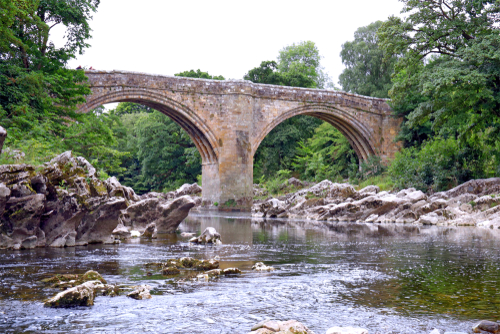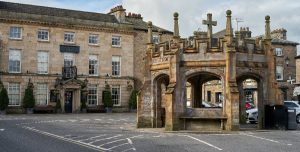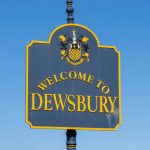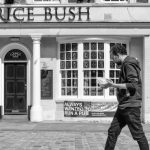
Kirkby Lonsdale is a uniquely placed historic market town almost straddling two of Englands finest National parks The Lake District and the Yorkshire Dales! How cool is that?
Where Is Kirby Lonsdale

The Market Square
Image: Quirky Badger/Shutterstock.com
Kirkby Lonsdale is a small town and civil parish in the South Lakeland district of Cumbria, northwest England. The town is situated on the River Lune. It lies 13 miles (21 km) southeast of Kendal along the A65. The town had a recorded population of 1,843 in the 2011 UK Census.
A Fleeting History
The Neolithic stone circle on Casterton Fell, as well as the remains of Celtic settlements at Barbon, Middleton and Hutton Roof, strongly suggest there was a good deal of settlement around the Kirkby Stephen area that pre-dates the 1st-century Roman occupation of Britain. When the Romans did arrive in Kirkby Lonsdale in the late 1st century, they built a road linking their forts at Low Borrow Bridge, near Tebay, and Over Burrow, just south of Kirkby Lonsdale, close to the River Lune.
The initial settlement of Kirkby Lonsdale developed at a ford crossing over the River Lune, where drovers’ and pack-horse routes converged. It’s one of few Cumbrian towns mentioned in the Domesday Book, where the town’s name was recorded as ‘Cherchibi’ – a village with a church. The existing church was rebuilt by the Normans, who also erected a ‘motte and bailey’ castle nearby, as a seat of power. In later years, the motte (mound) was used for cockfighting, eventually becoming known as Cockpit Hill.
In 1093, Ivo de Taillebois, the Baron of Kendal, conferred the tenure of Kirkby Lonsdale’s church to St Mary’s Abbey in York, which it held until the Dissolution of the Monasteries in 1536. Thereafter, the Abbey and its assets, including St Mary’s Church at Kirkby Lonsdale, were transferred to Trinity College, Cambridge, which retains the patronage to this day.
In the 12th century, a small market began to develop adjacent to the church. In 1227, a market charter was granted to John de Kirkby, which enabled a Thursday weekly market and fortnightly livestock fairs to be held in the town.
An Expanding Market Town
In 1692, a traveller recorded that Kirkby Lonsdale’s market and fairs “afford a great store of cattle and all sorts of grain in great plenty”. And, still late in the 17th century, Sir Daniel Fleming of Rydal, a noted antiquarian and politician of the time, described Kirkby as ”a Towne of note”, further remarking it was second only to Kendal in size.
In 1753, the Keighley to Kendal turnpike road opened passing through Kirkby Lonsdale. It met with another turnpike that ran to Milnthorpe, on the Cumbrian coast. By the end of the 18th century, the tanning and weaving industries had been established in the town. By this time, Mill Brow with its fast-flowing stream was the industrial heart of Kirkby Lonsdale, providing water power for an array of businesses and manufacturers. The weekly market, passing drovers and pack-horse riders helped to create a busy town centre. However, the travellers were well served by the town’s 29 inns and alehouses.
In 1822, the town’s bustling but small marketplace, which had served the town well for six centuries, was replaced by a much bigger market square, located on the A65, Kendal-Skipton road. By the mid-19th century, carpet makers, blanket makers and leather makers, as well as textile printers, were all employers in Kirkby Lonsdale.
The Railway Arrives
In 1861, a railway station was opened at Cowan Bridge, on the Skipton to Ingleton branch line, about 2 miles (3 km) from Kirkby Lonsdale. The railway line, never a great success, was closed to passengers in 1954 and dismantled in 1967. The formation of the railway track was then utilised in the construction of the re-aligned A65 trunk road.
Throughout the 19th century, the Kirkby Lonsdale remained modest in size. In 1801, during the first census of Great Britain, the population of the town was recorded as 1,283. During the ninety years, it was to rise by a meager 519 people. By the turn of the century, a great deal of the town’s industrial activity had ceased.
In 1932, a major change came to the town when the ancient Devil’s Bridge was closed to traffic. However, the crossing was superseded by Stanley Bridge, which was constructed 150 m to the South. By 1951, the town’s population was only 1,240, a little lower than it had been 150 years beforehand.
The Modern Era
Today, Kirkby Lonsdale remains an industrious market town, although the economy has an ever-increasing reliance on tourism.
The town centre is a mix of stylish 18th-century buildings and stone cottages with cobbled courtyards and narrow alleyways. The street names, such as Salt Pie Lane and Jingling Lane, are distinctly medieval in origin.
If you happen to visit Kirkby Lonsdale on a Sunday, especially through the summer months, you’ll probably find yourself in the company of a good number of friendly motorcycle enthusiasts. The town’s Devil’s Bridge has been a popular meeting place for ‘bikers’ for many years and their enthusiasm for Kirkby Lonsdale shows no sign of waning. The river around Devil’s Bridge is also popular with scuba divers due to its location, deep rock pools and good visibility.
Devil’s Bridge – A Ripping Yarn!
The town’s most iconic structure is the Grade I listed, a three-arched medieval bridge, that crosses the River Lune, known as ‘Devil’s Bridge‘. The exact date of its construction is unknown, and while some pundits deem it to be the late 12th century, others date it nearer 1370. It’s also unclear who actually built the bridge, but it seems likely it was the work of monks from St Mary’s Abbey in York.
However, there is another theory as to who might have built the bridge. The structure is associated with common folklore for bridges of the same name, albeit with minor regional variation. The Kirkby Lonsdale version tells of an old woman who lived on the banks of the Lune. One night her cow strayed across the river, which the woman was unable to coax back to its meadow. Suddenly, the Devil appeared and offered to build her a bridge across the river in exchange for the first soul to cross it.
The desperate old woman felt obliged to agree to the fiendish proposal. However, once the Devil had finished the construction of the bridge, the woman bizarrely took a bread bun from her bag and threw it over the river. Her small dog immediately darted off across the new bridge to retrieve the bun. The Devil expecting to gain a human soul realised he’d been outwitted and flew into a rage. He then vanished in a puff of smoke but not before leaving his handprint in the stonework of the bridge – which you can still see today!
How to get To Kirkby Lonsdale
By Road
Kirkby Lonsdale is on A65, 13 miles south of Kendal. From the M6 junction 36, take the A65 south for 6 miles, or from junction 34, take the A683 for 15 miles.
By train
The nearest mainline train station to Kirkby Lonsdale is Oxenholme, 11 miles away, while Lancaster is 20 miles away. Wennington on the Leeds to Morecambe line is a little closer but presents public transport travel challenges. There’s an infrequent connecting bus service from Oxenholme to Kirkby Lonsdale but the service from Lancaster is much better, taking about 50 minutes.
By coach
National Express buses run daily to/from Kendal (14 miles) and Lancaster (20 miles).
By Air
Carlisle Lake District Airport is now open, offering flights from Dublin, Belfast and London Southend. Otherwise, it’s Manchester!
Things to see and do!
Ruskin’s View
In 1822, the world-renowned artist JMW Turner famously painted a view of the River Lune from St Mary’s churchyard in Kirkby Stephen. The writer, poet, art critic and social commentator, John Ruskin, greatly extolled the virtues of the work, writing; “I do not know in all my country, still less in France or Italy, a place more naturally divine”. In time, the painting became known as Ruskin’s View, drawing in Victorian tourists to the area. In 1875, Ruskin described the panorama as “one of the loveliest views in England, therefore in the world”. The painting was last sold at an auction in London in January 2012 to a private UK buyer for a price of £217,250.
St Mary’s Church
The ancient church of St Mary is thought to date back to 1093. With its Norman architecture, it is a designated Grade I listed building.
The Radical Steps
The “Radical Steps” lead down from St Mary’s Churchyard to the River Lune, close to Ruskin’s View. The steps were built in 1820 to divert an existing public footpath away from the garden of the perturbed Dr. Francis Pearson. However, building the new steps caused a local controversy, and hence, they became known as the “Radical Steps”.
Victorian Fair
One of the highlights of the Kirkby Lonsdale calendar is the annual Victorian Fair. The festival’s aim is to recreate the atmosphere of a 19th-century fair, complete with street entertainment, stalls, and a market. The Fair takes place annually, on the first weekend of September.
Did you know?
In 1824, the famed 19th-century literary family, the Bronte sisters, attended the Clergy Daughters’ School in Cowan Bridge, just 2 miles from Kirkby Lonsdale. Unfortunately, the two elder siblings of the four sisters, Maria and Elizabeth, died from tuberculosis in the aftermath of a typhoid outbreak at the school.
Where to stay?
There are about 8 or 9 places to stay within Kirkby Lonsdale itself, which are either; family hotel / B and B, style accommodation. There are also a few other similar properties within a 5-mile radius. They all fall within a similar price range of about £75 – £100 per night for 2 adults sharing. Holiday lets provide an alternative but could work much pricier.
Why not take the Kirkby Lonsdale quiz?
Quiz Maker – powered by Riddle


